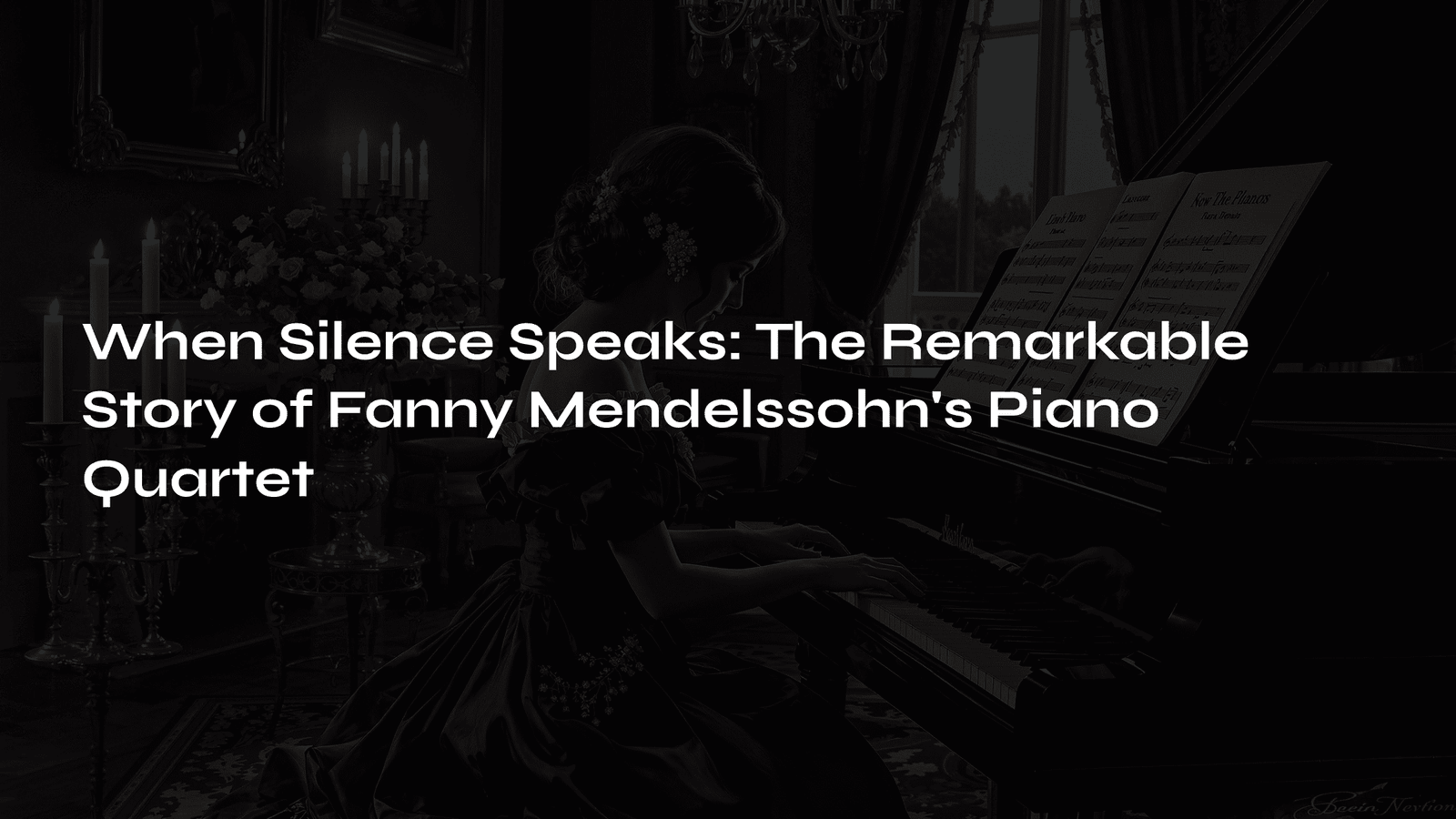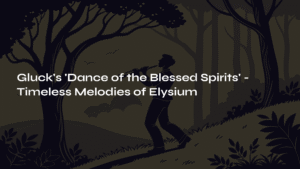Table of Contents
Have you ever found yourself lost in a piece of music, completely captivated by its beauty, only to wonder about the person behind those notes? I remember sitting in a dimly lit concert hall, the world around me fading away as the first notes of a piano quartet filled the space. There was something different about this music – something both familiar yet distinctly unique. What I didn’t know then was that I was experiencing the genius of one of history’s most overlooked composers.
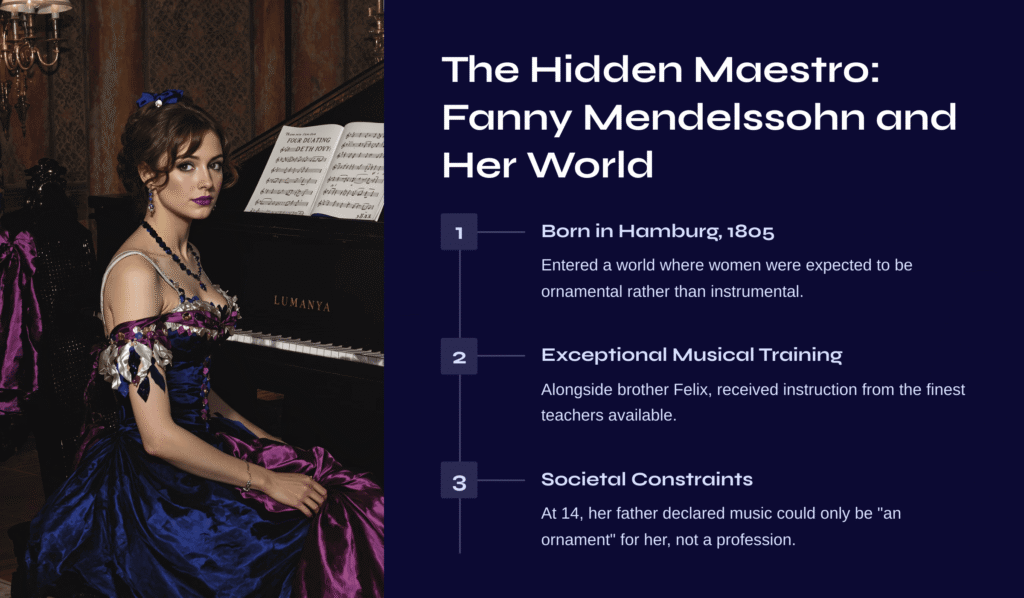
The Hidden Maestro: Fanny Mendelssohn and Her World
Born in Hamburg in 1805, Fanny Mendelssohn entered a world where women were expected to be ornamental rather than instrumental. Despite this, she was fortunate to be born into a wealthy, cultured family that valued education. Alongside her younger brother Felix (who would later become one of the Romantic era’s most celebrated composers), Fanny received exceptional musical training from the finest instructors available, including Carl Friedrich Zelter, a friend of the great poet Goethe.
What makes Fanny’s story so compelling is the stark contrast between her undeniable talent and the societal constraints she faced. While both siblings showed extraordinary musical gifts, their paths were destined to diverge. At just 14 years old, Fanny received a letter from her father stating that while music might become Felix’s profession, for her it “must only be an ornament.” This single sentence encapsulates the frustrating reality for female composers of the era – exceptional talent relegated to the domestic sphere.
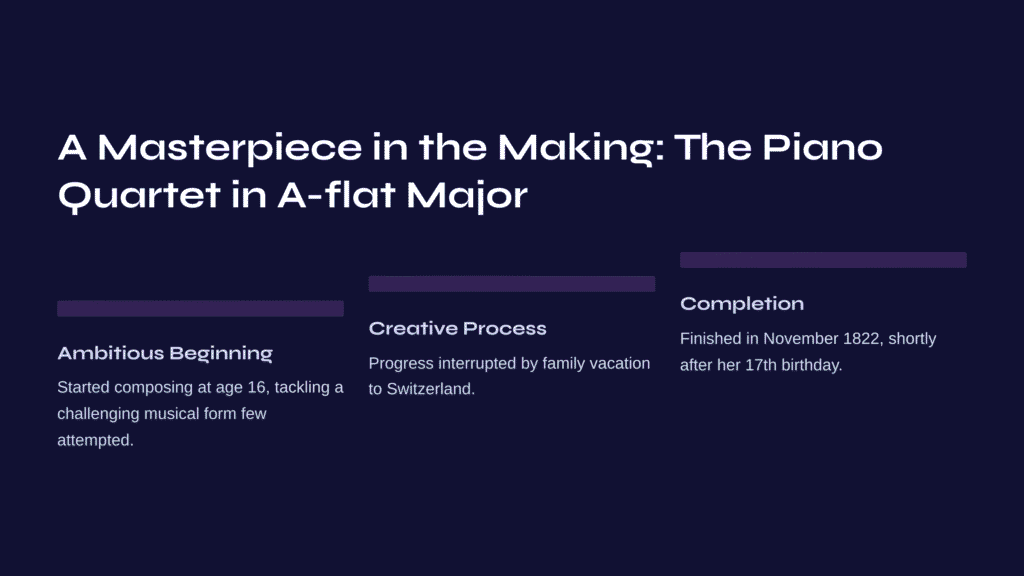
A Masterpiece in the Making: The Piano Quartet in A-flat Major
Against this backdrop, the creation of Fanny’s Piano Quartet in A-flat Major becomes even more remarkable. Composed in 1822 when she was merely 17 years old, this ambitious work represents her first major chamber composition. To put this in perspective, this was an era when piano quartets were relatively uncommon, with Mozart’s quartets being among the few prominent examples. For a teenage girl to tackle such a challenging form demonstrates extraordinary confidence and ambition.
Fanny began work on this piece at 16, though her progress was interrupted by a family vacation to Switzerland. She ultimately completed it in November 1822, shortly after her 17th birthday. Interestingly, her brother Felix had composed his own piano quartet just a year earlier at age 12, perhaps inspiring Fanny to showcase her own abilities in a larger musical format.
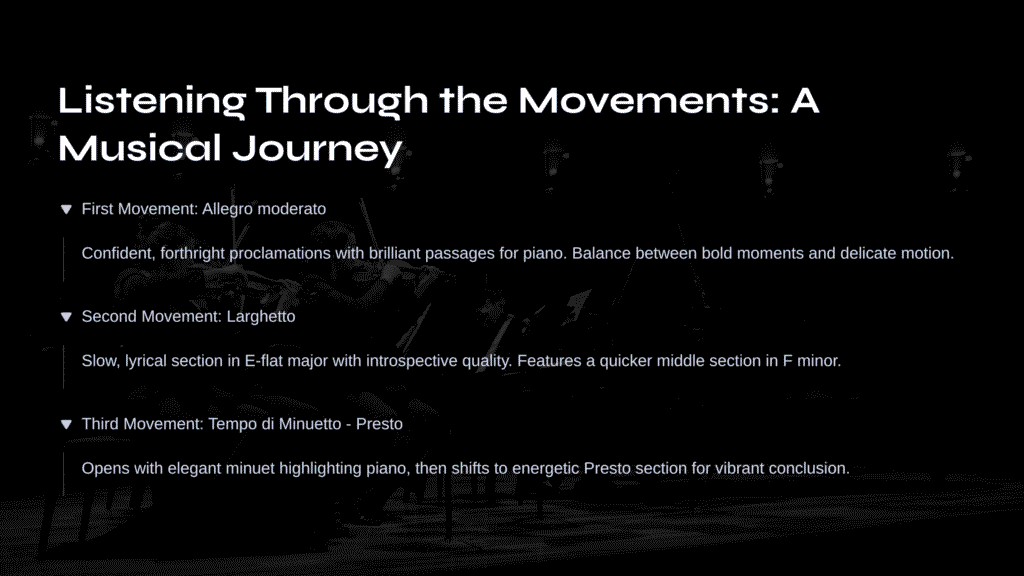
Listening Through the Movements: A Musical Journey
The Piano Quartet unfolds across three movements, each revealing different facets of Fanny’s precocious talent:
First Movement: Allegro moderato
The opening movement immediately catches your attention with its confident, forthright proclamations. If you listen closely, you can hear brilliant passages for the piano that showcase Fanny’s own virtuosic abilities as a performer. There’s a fascinating balance here between bold, assertive moments and more delicate, “Classical” motion. The piano takes center stage throughout, dancing through scintillating figurations that would challenge even accomplished pianists.
What strikes me most about this movement is how it manages to feel both structured and free-flowing. Fanny works within a modified sonata form but brings her own distinctive voice to this traditional framework. Listen for the way themes develop and transform, showing a sophisticated understanding of musical architecture that belies the composer’s youth.
Second Movement: Larghetto
The second movement begins with a slow, lyrical section in E-flat major that immediately changes the emotional landscape. There’s a sense of introspection here, as if we’re being invited into Fanny’s private thoughts. This outer section envelops a quicker middle section in F minor, creating a beautiful contrast that showcases her expressive range.
What I find most moving about this movement is how it reveals Fanny’s gift for melody. The lines unfold with natural grace, yet there’s nothing simplistic about them. If you close your eyes while listening, you might find yourself visualizing scenes of contemplative beauty – perhaps reflecting the Swiss landscapes Fanny had recently experienced during her family vacation.
Third Movement: Tempo di Minuetto – Presto
The final movement opens with an elegant minuet that once again highlights the piano. There’s a courtly grace here, reminiscent of an earlier musical era but infused with Romantic sensibility. Then, without warning, we’re swept into an energetic Presto section that brings the work to a vibrant conclusion.
This movement showcases Fanny’s ability to shift effortlessly between different characters and tempos. The transition from the measured elegance of the minuet to the exuberant energy of the Presto creates a satisfying emotional arc that leaves listeners exhilarated.

A Personal Connection: Why This Music Matters
Whenever I listen to Fanny Mendelssohn’s Piano Quartet, I’m struck by a sense of both wonder and melancholy. Wonder at the extraordinary achievement this represents – a teenage girl creating sophisticated chamber music in the early 19th century. Melancholy at the thought of how many other compositions might have emerged had she been given the same opportunities as her brother.
There’s something uniquely intimate about chamber music – it feels like overhearing a conversation among friends. In Fanny’s quartet, that conversation feels particularly meaningful, perhaps because it represents one of the few ways she could fully express her musical voice. While her brother’s works were performed in concert halls across Europe, Fanny’s compositions were primarily heard in the “Sonntagsmusiken” (Sunday Musical Performances) she organized in her Berlin home after marrying court painter Wilhelm Hensel in 1829.
In a way, this makes listening to her music today an act of historical justice – finally giving her work the public hearing it always deserved.
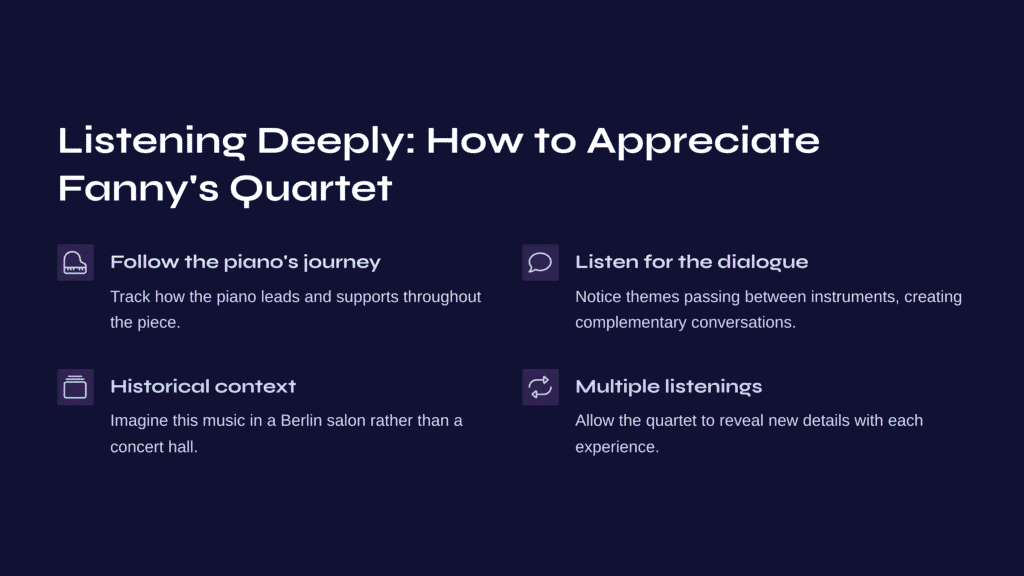
Listening Deeply: How to Appreciate Fanny’s Quartet
If you’re new to this piece, or to chamber music in general, here are some suggestions for deepening your appreciation:
- Follow the piano’s journey: Since Fanny was an exceptional pianist (having memorized Bach’s complete Well-Tempered Clavier by age 13!), the piano part is particularly rewarding to track throughout the quartet. Notice how it sometimes leads the conversation and at other times supports the string instruments.
- Listen for the dialogue: Chamber music is fundamentally conversational. Pay attention to how themes and motifs are passed between instruments, sometimes complementing each other and sometimes creating productive tension.
- Compare with Felix: If you’re familiar with Felix Mendelssohn’s work, listening to Fanny’s compositions offers fascinating insights into their shared musical language. While distinctly her own voice, you can hear the influence of their common education and musical environment.
- Historical context: Try to imagine this music being performed in a Berlin salon rather than a concert hall. This was intimate music, meant to be shared among friends and family in a domestic setting.
- Multiple listenings: Like any complex work of art, this quartet reveals new details with each listening. Don’t be surprised if passages that didn’t immediately grab your attention become favorites over time.
I particularly recommend the Kaleidoscope Chamber Collective’s recording from 2022, which features Elena Urioste on violin, Rosalind Ventris on viola, Laura van der Heijden on cello, and Tom Poster on piano. Their sensitive interpretation brings out the nuances of Fanny’s writing while maintaining the youthful energy that infuses the work.
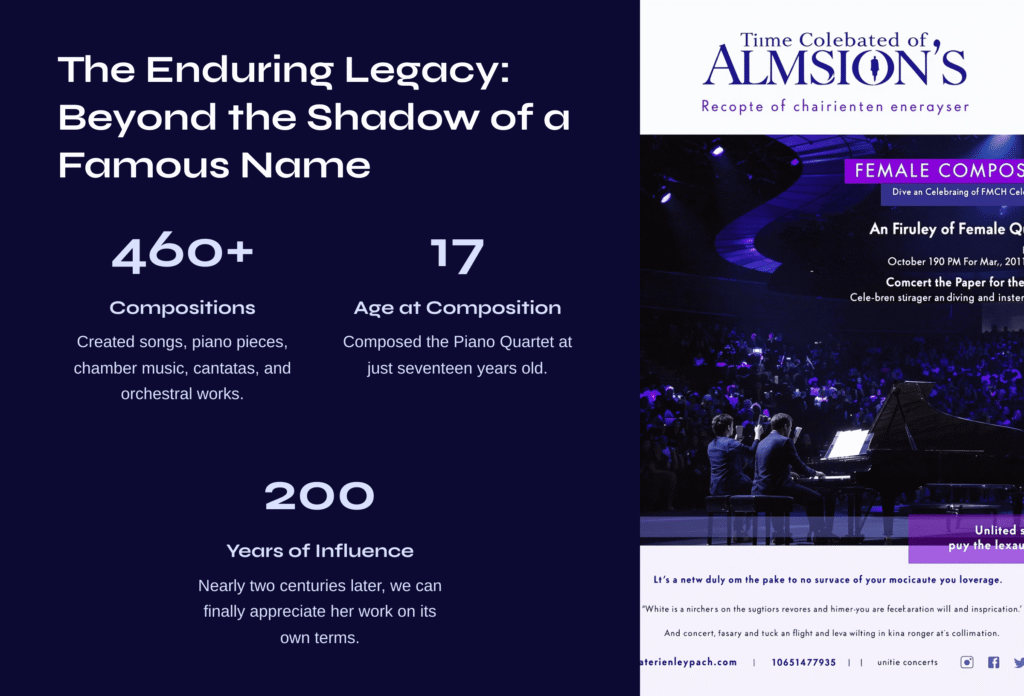
The Enduring Legacy: Beyond the Shadow of a Famous Name
For too long, Fanny Mendelssohn existed primarily as a footnote in her brother’s biography. Today, nearly two centuries after she composed her Piano Quartet, we can finally appreciate her work on its own terms. Despite creating over 460 compositions – including songs, piano pieces, chamber music, cantatas, and even orchestral works – Fanny’s music remained largely unpublished during her lifetime.
The Piano Quartet in A-flat Major stands as compelling evidence of what might have been had she been born in a different era. It reveals a composer of remarkable sophistication, melodic invention, and structural understanding – all at the age of 17. While we cannot rewrite history, we can ensure that her music is heard, appreciated, and celebrated today.
As I sit listening to the final movement of the quartet, I’m struck again by the paradox at its heart – how something created in such constrained circumstances can itself feel so free. Perhaps that’s the ultimate testament to Fanny Mendelssohn’s genius: her ability to transcend the limitations imposed upon her through the sheer force of her musical imagination.
In the end, what resonates most powerfully is not the story of what might have been, but the miracle of what actually was – a young woman with extraordinary gifts who found a way to express them despite everything. Her Piano Quartet doesn’t just speak to us across the centuries; it sings.
If You Loved This, Listen to This Next

If you were captivated by Fanny Mendelssohn’s expressive piano writing and emotional depth in this quartet, you might find yourself equally enchanted by The Moonlight Sonata: Beethoven’s Emotional Journey Through Piano – where similar introspective qualities and revolutionary spirit create an intimate musical experience that resonates across centuries.
Both works reveal how composers channeled personal struggles into transcendent music that continues to move listeners today.
